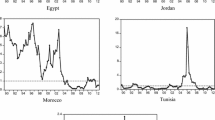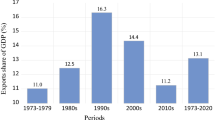Abstract
This paper re-examines the relationship between exports and economic growth in OECD countries. We apply the multi-horizon causality method developed by Dufour et al. (J Econ 132(2):337–362, 2006) for the first time, taking into account the possibility of infrequent structural trend breaks. Econometric techniques that avoid the circular problem when testing for segmented trends and unit roots have been employed along with a hybrid estimator of break location. The empirical evidence indicates that there is a unidirectional causal relationship from exports to economic growth for Finland, Germany, and the United States in the short run horizon, and directly in the cases of Austria and Ireland. We verify a direct causal relation from economic growth to real exports in France, Luxembourg and Portugal in various continuous horizons. Bidirectional causal relations between exports and economic growth were detected in Greece and Norway.
Similar content being viewed by others
Notes
The hypothesis that export causes economic growth is called the export-led growth hypothesis.
Hill (2007) provides an alternative efficient testing methodology for multi-horizon causality in trivariate VAR systems.
References
Afxentiou P, Serletis A (1991) Exports and GNP causality in the industrial countries: 1950–1985. Kyklos 44:167–179
Ahmed J, Kwan ACC (1991) Causality between exports and economic growth. Econ Lett 37:243–248
Ambler S, Cardia E, Fazarli J (1999) Export promotion, learning by doing and growth. J Econ Dyn Contr 23:747–772
Awokuse TO (2003) Is the export-led growth hypothesis valid for Canada? Canad J Econ 36(1):126–136
Bahmani-Oskooee M, Mohtadi H, Shabsigh G (1991) Exports, growth and causality in LDCs: a re-examination. J Develop Econ 36:405–415
Balaguer J, Cantavella-Jorda M (2004) Export composition and Spanish economic growth: evidence from the 20th century. J Pol Model 26:165–179
Balassa B (1978) Export and economic growth: further evidence. J Develop Econ 5(2):181–189
Balassa B (1985) Exports, policy choices, and economic growth in developing countries after the 1973 oil shocks. J Develop Econ 18(1):23–35
Bhagawati JN (1988) Export-promoting trade strategies: issues and evidence. World Bank Res Observ 3(1):27–57
Bhagwati JN, Srinivasan TN (1979) Trade policy and development. In: Dornbusch R, Frenkel JA (eds) International economic policy: theory and evidence. John Hopkins University Press, Baltimore, p 1–38
Blumenthal T (1972) Exports and economic growth: the case of postwar Japan. Quart J Econ 86(4):617–631
Chow P (1987) Causality between exports growth and industrial development. J Develop Econ 26:55–63
Chun S, Perron P (2013) Comparisons of robust tests for shifts in trend with an application to trend deviations of real exchange rates in the long run. Appl Econ 45(24):3512–3528
Coe DT, Helpman E (1995) International R&D spillovers. Eur Econ Rev 39(5):859–887
Dickey DA, Fuller WA (1979) Distribution of the estimators for autoregressive time series with a unit root. J Am Stat Assoc 74(366):427–431
Dolado JJ, Lütkepohl H (1996) Making Wald tests work for cointegrated VAR systems. Econ Rev 15:369–386
Dorado S (1993) Exports and growth: a reconsideration of causality. J Develop Area 27(2):227–244
Dufour J-M, Renault E (1998) Short-run and long-run causality in time series: theory. Econometrica 66(5):1099–1125
Dufour J-M, Pelletier D, Renault E (2006) Short run and long run causality in time series: inference. J Econ 132(2):337–362
Elliott G, Rothenberg TJ, Stock JH (1996) Efficient tests for an autoregressive unit root. Econometrica 64(4):813–836
Feder G (1982) On exports and economic growth. J Develop Econ 12:59–73
Ghoshray A, Kejriwal M, Wohar M (2014) Breaks, trends and unit roots in commodity prices: a robust investigation. Stud Nonline Dyn Econ 18(1):23–40
Granger CWJ (1969) Investigating causal relationships by econometric models and cross-spectral models. Econometrica 37:424–438
Grossman GM, Helpman E (1990) Trade, innovation, and growth. Am Econ Rev 80(2):86–91
Grosssman GM, Helpman E (1991) Trade, knowledge spillovers, and growth. Eur Econ Rev 35:517–526
Harvey DI, Leybourne SJ (2014) Break date estimation for models with deterministic structural change. Oxford Bull Econ Stat 76(5):623–642
Harvey DI, Leybourne SJ, Taylor AMR (2009) Simple, robust and powerful tests of the breaking trend hypothesis. Econ Theor 25(4):995–1029
Harvey DI, Leybourne SJ, Taylor AMR (2013) Testing for unit roots in the possible presence of multiple trend breaks using minimum Dickey-Fuller statistics. J Econ 177:265–284
Helpman E, Krugman P (1985) Market structure and foreign trade. MIT Press, Cambridge
Henriques I, Sadorsky P (1996) Export-led growth or growth-driven exports? The Canadian case. Canad J Econ 29(3):540–555
Hill JB (2007) Efficient tests of long-run causation in trivariate VAR processes with a rolling window study of the money-income relationship. J Appl Econ 22:747–765
Jun S (2007) Bi-directional relationship between exports and growth: a panel cointegration analysis. J Econ Res 12:133–171
Jung WS, Marshall PJ (1985) Exports, growth and causality in development countries. J Develop Econ 18:1–12
Kavoussi RM (1984) Export expansion and economic growth: further empirical evidence. J Develop Econ 17:241–250
Kejriwal M, Lopez C (2013) Unit roots, level shifts, and trend breaks in per capita output: a robust evaluation. Econ Rev 32(8):892–927
Kejriwal M, Perron P (2010) A sequential procedure to determine the number of breaks in trend with an integrated or stationary noise component. J Time Ser Anal 31:305–328
Konya L (2006) Exports and growth: granger causality analysis on OECD countries with a panel data approach. Econ Model 23:978–992
Kunst RM, Marin D (1989) On exports and productivity: a causal analysis. Rev Econ Stat 71:699–703
Kwan ACC, Cotsomitis JA (1991) Economic growth and the expanding export sector: China 1952–1985. Int Econ J 5(1):105–116
Kwiatkowski D, Phillips PCB, Schmidt P, Shin Y (1992) Testing the null hypothesis of stationarity against the alternative of a unit root: how sure are we that economic time series have a unit root? J Econ 54(1–3):159–178
Marin D (1992) Is the export-led growth hypothesis valid for industrialized countries? Rev Econ Stat 74(4):678–688
McKinnon RI (1964) Foreign exchange constraints in economic development and efficient aid allocation. Econ J 74(294):388–409
Michaely M (1977) Exports and growth. J Develop Econ 4:49–53
Michalopoulos C, Jay KE (1973) Growth of exports and income in the developing world: a neoclassical view. Department of State Agency for International Development, Bureau for Policy Coordination. Discussion paper No. 28
Moosa IA (1999) Is the export-led growth hypothesis valid for Australia? Appl Econ 31:903–906
Ng S, Perrron P (2001) Lag length selection and the construction of unit root tests with good size and power. Econometrica 69(6):1519–1554.
Ng S, Vogelsang T (2002) Analysis of vector autoregressions in the presence of shifts in mean. Econ Rev 21(3):353–381
Panas E, Vamvoukas G (2002) Further evidence on the export-led growth hypothesis. Appl Econ Lett 9(11):731–735
Perron P (1989) The great crash, the oil price shock, and the unit root hypothesis. Econometrica 57:1361–1401
Perron P, Yabu T (2009) Testing for shifts in trend with an integrated or stationary noise component. J Business Econ Stat 27(3):369–396
Phillips PCB, Perron P (1988) Testing for a unit root in time series regression. Biometrika 75(2):335–346
Pistoresi B, Rinaldi A (2012) Exports, imports and growth: new evidence on Italy, 2863–2004. Explor Econ History 49:241–254
Ram R (1985) Exports and economic growth: some additional evidence. Econ Develop Cult Chang 33(2):415–425
Ram R (1987) Exports and economic growth in developing countries: evidence from time-series and cross-section data. Econ Develop Cult Chang 36(1):51–72
Ramos FR (2001) Exports, imports, and economic growth in Portugal: evidence from causality and cointegration analysis. Econ Model 18:613–623
Riezman RG, Whiteman CH, Summers PM (1996) The engine of growth or its handmaiden? A time-series assessment of export-led growth. Emp Econ 21:77–110
Serletis A (1992) Export growth and Canadian economic development. J Develop Econ 38:133–145
Shan J, Sun F (1998) Export-led growth hypothesis for Australia: an empirical re-investigation. Appl Econ Lett 5:423–428
Shan J, Sun F (1999) Export-led growth and the US economy: some further testing. Appl Econ Lett 6:169–172
Sharma SC, Dhakal D (1994) Causal analyses between exports and economic growth in developing countries. Appl Econ 26:1145–1157
Sharma SC, Norris M, Cheung DW-W (1991) Exports and economic growth in industrialized countries. Appl Econ 23:697–708
Sheehey EJ (1992) Exports and growth: additional evidence. J Develop Stud 28(4):730–734
Srinivasan TN (1986) Neoclassical political economy, the state and economic development. Asian Develop Rev 3(4):38–58
Thornton J (1997) Exports and economic growth: evidence from 19th Century Europe. Econ Lett 55:235–240
Toda HY, Yamamoto T (1995) Statistical inference in vector autoregressions with possibly integrated processes. J Econ 66(1–2):225–250
Tyler WG (1981) Growth and export expansion in developing countries. J Develop Econ 9:121–130
Yamada H (1998) A note on the causality between export and productivity: an empirical re-examination. Econ Lett 61:111–114
Zapata HO, Rambaldi AN (1997) Monte Carlo evidence on cointegration and causation. Oxford Bull Econ Stat 59(2):285–298
Author information
Authors and Affiliations
Corresponding author
Rights and permissions
About this article
Cite this article
Konstantakopoulou, I. The aggregate exports-GDP relation under the prism of infrequent trend breaks and multi-horizon causality. Int Econ Econ Policy 14, 661–689 (2017). https://doi.org/10.1007/s10368-016-0355-1
Published:
Issue Date:
DOI: https://doi.org/10.1007/s10368-016-0355-1




